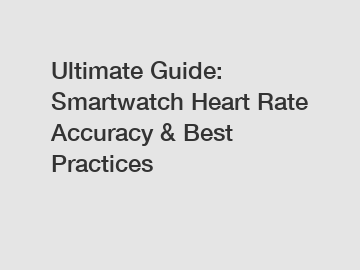Ultimate Guide: Smartwatch Heart Rate Accuracy & Best Practices
Smartwatches have taken the world by storm, revolutionizing the way we engage with technology and monitor our health. Among their many impressive features, the ability to track our heart rate stands out as one of the most significant. However, there is an ongoing debate about the accuracy of heart rate measurements on smartwatches. In this comprehensive guide, we will delve into the intricacies of smartwatch heart rate accuracy, offering best practices to ensure reliable readings. .
Chapter 1: Understanding Heart Rate Monitoring on Smartwatches.
To truly grasp the power of heart rate monitoring on smartwatches, it's crucial to comprehend the underlying technology. Our smartphones utilize optical sensors, equipped with green LED lights and photodiodes, to track the flow of blood through our capillaries, translating it into heart rate data.

Chapter 2: Interpreting Accuracy vs. Precision.
When discussing heart rate accuracy, it's important to differentiate between accuracy and precision. While accuracy refers to how close the measurements are to the actual heart rate, precision focuses on the consistency of measurements in repeated tests. Understanding this distinction helps us better evaluate the reliability of our smartwatch readings.
Chapter 3: Factors Affecting Heart Rate Accuracy.
Accurate heart rate monitoring can be impacted by various factors. Skin type, ambient temperature, tightness of the watch strap, and even the individual's level of physical activity can all affect the readings. Furthermore, factors like tattoos, ambient light, and sweat can interfere with the optical sensors, resulting in less reliable measurements.
Chapter 4: Best Practices for Accurate Heart Rate Monitoring.
To enhance the accuracy of heart rate measurements on your smartwatch, follow these best practices:
1. Proper Fit: Ensure that the watch strap is snug but not too tight, allowing the optical sensors to remain in contact with your skin.
2. Placement: Position the watch on the wrist's underside, closer to the radius bone, where the skin is less prone to movement and interference.
3. Calm State: When taking heart rate measurements, try to remain as still as possible, with your wrist at heart level. Minimizing movement and external factors plays a crucial role in obtaining accurate readings.
4. Skin Preparation: Make sure your skin is clean and dry before wearing the smartwatch. Moisturizers, oils, or dirt on the skin can hinder the optical sensors' ability to obtain accurate readings.
5. Consistency: Track your heart rate under similar conditions to establish a baseline. Comparing readings taken at different times, such as before and after exercising, can help identify any inconsistencies or improvements needed.
Chapter 5: The Human Factor in Heart Rate Monitoring.
Heart rate monitoring is a dynamic process influenced by individual variations. Factors like age, fitness level, body mass index, and even emotional states can affect heart rate readings. Understanding these nuances helps put your smartwatch data into context, recognizing that heart rate measurement is a multifaceted process influenced by both internal and external factors.
Chapter 6: Seeking Professional Advice.
While smartwatch heart rate monitoring is a valuable tool for most people, individuals with specific health concerns should always consult with a medical professional. Those with pre-existing cardiac conditions or who are pregnant may require tailored monitoring solutions for accurate heart rate assessment and interpretation.
Conclusion: .
To sum it up, smartwatches offer a convenient and accessible means of monitoring our heart rate and overall health. While it is essential to understand the limitations and factors that can affect the accuracy of heart rate measurements, adhering to best practices can significantly enhance reliability. Remember, smartwatch heart rate monitoring complements professional medical advice rather than replacing it. Armed with this knowledge, you can confidently make informed decisions on utilizing the heart rate tracking capabilities of your smartwatch.
For more smart watch manufacturer, odm smartwatch, smart health watchinformation, please contact us. We will provide professional answers.



Comments
0